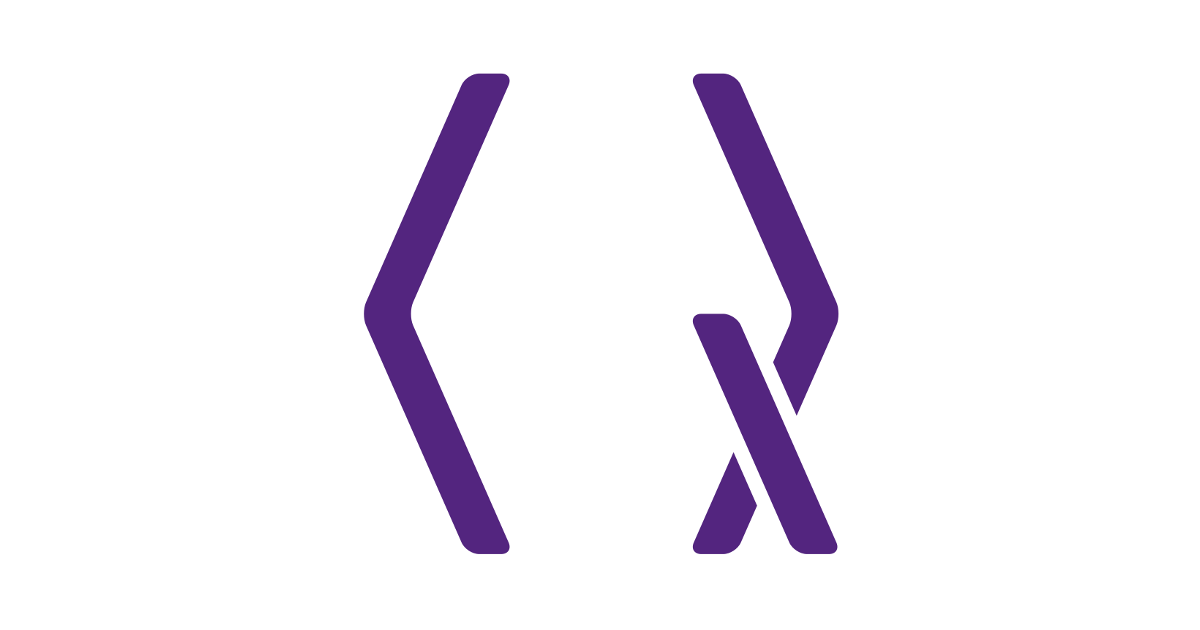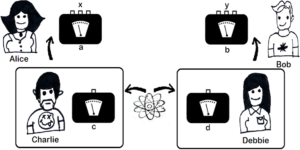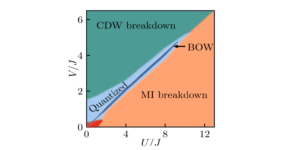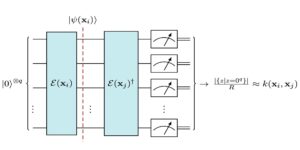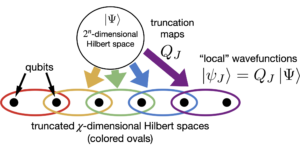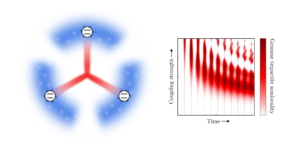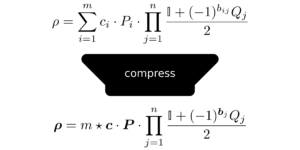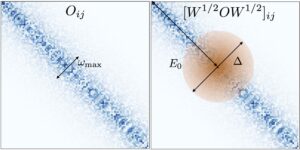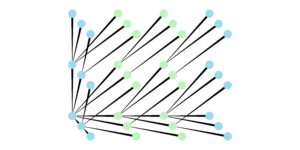1Instituto de Física, Facultad de Física, Astronomía e Informática, Universidad Nicolaus Copernicus, Grudziadzka 5/7, 87-100 Toruń, Polonia
2Institut für Theoretische Physik, Technische Universität Dresden, D-01062, Dresden, Alemania
3Centro Turku de Física Cuántica, Departamento de Física y Astronomía, Universidad de Turku, FI-20014, Turun Yliopisto, Finlandia
4Dipartimento di Fisica “Aldo Pontremoli”, Università degli Studi di Milano, Via Celoria 16, I-20133 Milán, Italia
5Istituto Nazionale di Fisica Nucleare, Sezione di Milano, Via Celoria 16, I-20133 Milán, Italia
¿Encuentra este documento interesante o quiere discutirlo? Scite o deje un comentario en SciRate.
Resumen
Toda dinámica de sistemas abiertos puede asociarse a una infinidad de imágenes estocásticas, llamadas desentrañamientos, que han demostrado ser extremadamente útiles en varios contextos, tanto desde el punto de vista conceptual como práctico. Aquí, centrándonos en los desciframientos de salto cuántico, demostramos que existe una libertad inherente en cómo asignar los términos de la ecuación maestra subyacente a las partes deterministas y de salto de la descripción estocástica, lo que conduce a una serie de desciframientos cualitativamente diferentes. Como ejemplos relevantes, mostramos que se puede seleccionar una base fija de estados posteriores al salto bajo algunas condiciones definidas, o que la evolución determinista se puede establecer mediante un hamiltoniano no hermitiano independiente del tiempo elegido, incluso en presencia de una conducción externa. Nuestro enfoque se basa en la definición de operadores de tasa, cuya positividad dota a cada desdoblamiento de un esquema de medición continua y está relacionado con una propiedad conocida desde hace mucho tiempo pero hasta ahora poco utilizada para clasificar la dinámica cuántica, conocida como disipatividad. A partir de conceptos matemáticos formales, nuestros resultados nos permiten obtener información fundamental sobre la dinámica de sistemas cuánticos abiertos y enriquecer sus simulaciones numéricas.
► datos BibTeX
► referencias
[ 1 ] H.-P. Breuer y F. Petruccione, The Theory of Open Quantum Systems (Oxford Univ. Press, Oxford, 2007).
https: / / doi.org/ 10.1093 / acprof: oso / 9780199213900.001.0001
[ 2 ] HJ Carmichael, An Open System Approach to Quantum Optics, Lectures Notes in Physics (Springer, Berlín, 1993).
https://doi.org/10.1007/978-3-540-47620-7
[ 3 ] J. Dalibard, Y. Castin y K. Mølmer, Phys. Rev. Lett. 68, 580 (1992).
https: / / doi.org/ 10.1103 / PhysRevLett.68.580
[ 4 ] T. Basche, S. Kummer y C. Brauchle, Nature 373, 132 (1995).
https: / / doi.org/ 10.1038 / 373132a0
[ 5 ] S. Peil y G. Gabrielse, Phys. Rev. Lett. 83, 1287 (1999).
https: / / doi.org/ 10.1103 / PhysRevLett.83.1287
[ 6 ] F. Jelezko, I. Popa, A. Gruber, C. Tietz, J. Wrachtrup, A. Nizovtsev y S. Kilin, Appl. física Letón. 81, 2160 (2002).
https: / / doi.org/ 10.1063 / 1.1507838
[ 7 ] S. Gleyzes, S. Kuhr, C. Guerlin, J. Bernu, S. Deléglise, UB Hoff, M. Brune, J.-M. Raimond y S. Haroche, Nature 446, 297 (2007).
https: / / doi.org/ 10.1038 / nature05589
[ 8 ] R. Vijay, DH Slichter e I. Siddiqi, Phys. Rev. Lett. 106, 110502 (2011).
https: / / doi.org/ 10.1103 / PhysRevLett.106.110502
[ 9 ] ZK Minev, SO Mundhada, S. Shankar, P. Reinhold, R. Gutiérrez-Jáuregui, RJ Schoelkopf, M. Mirrahimi, HJ Carmichael y MH Devoret, Nature 570, 200 (2019).
https: / / doi.org/ 10.1038 / s41586-019-1287-z
[ 10 ] MB Plenio y PL Knight, Rev. Mod. física 70, 101 (1998).
https: / / doi.org/ 10.1103 / RevModPhys.70.101
[ 11 ] AJ Daley, Adv. física 63, 77 (2014).
https: / / doi.org/ 10.1080 / 00018732.2014.933502
[ 12 ] I.Percival, Quantum State Diffusion (Cambridge University Press, Cambridge, Inglaterra, 2002).
[ 13 ] A. Barchielli y M. Gregoratti, Quantum Trajectories and Measurements in Continuous Time: The Difusive Case, Lecture Notes in Physics 782 (Springer, Berlín, 2009).
https://doi.org/10.1007/978-3-642-01298-3
[ 14 ] HM Wiseman y GJ Milburn, Phys. Rev. A 47, 1652 (1993).
https: / / doi.org/ 10.1103 / PhysRevA.47.1652
[ 15 ] WT Strunz, L. Diósi y N. Gisin, Phys. Rev. Lett. 82, 1801 (1999).
https: / / doi.org/ 10.1103 / PhysRevLett.82.1801
[ 16 ] T. Yu, L. Diósi, N. Gisin y WT Strunz, Phys. Rev. A 60, 91 (1999).
https: / / doi.org/ 10.1103 / PhysRevA.60.91
[ 17 ] K. Luoma, WT Strunz y J. Piilo, Phys. Rev. Lett. 125, 150403 (2020).
https: / / doi.org/ 10.1103 / PhysRevLett.125.150403
[ 18 ] KW Murch, SJ Weber, C. Macklin e I. Siddiqi, Nature 502, 211 (2013).
https: / / doi.org/ 10.1038 / nature12539
[ 19 ] P. Campagne-Ibarcq, P. Six, L. Bretheau, A. Sarlette, M. Mirrahimi, P. Rouchon y B. Huard, Phys. Rev. X 6, 011002 (2016).
https: / / doi.org/ 10.1103 / PhysRevX.6.011002
[ 20 ] S. Hacohen-Gourgy, LS Martin, E. Flurin, VV Ramasesh, KB Whaley e I. Siddiqi, Nature 538, 491 (2016).
https: / / doi.org/ 10.1038 / nature19762
[ 21 ] Q. Ficheux, S. Jezouin, Z. Leghtas y B. Huard, Nat. Com. 9, 1926 (2018).
https://doi.org/10.1038/s41467-018-04372-9
[ 22 ] A. Barchielli y VP Belavkin, J. Phys. R: Matemáticas. Gen. 24, 1495 (1991).
https://doi.org/10.1088/0305-4470/24/7/022
[ 23 ] E.-M. Laine, J. Piilo y H.-P. Breuer, Phys. Rev. A 81, 062115 (2010).
https: / / doi.org/ 10.1103 / PhysRevA.81.062115
[ 24 ] D. Chrusciński, A. Kossakowski y Á. Rivas, Ph. Rev. A 83, 052128 (2011).
https: / / doi.org/ 10.1103 / PhysRevA.83.052128
[ 25 ] A. Rivas y SF Huelga, Open Quantum Systems (Springer, Nueva York, 2012).
https://doi.org/10.1007/978-3-642-23354-8
[ 26 ] A. Rivas, SF Huelga y MB Plenio, Phys. Rev. Lett. 105, 050403 (2010).
https: / / doi.org/ 10.1103 / PhysRevLett.105.050403
[ 27 ] A. Rivas, SF Huelga, y MB Plenio, Rep. Prog. física 77, 094001 (2014).
https://doi.org/10.1088/0034-4885/77/9/094001
[ 28 ] H.-P. Breuer, E.-M. Laine y J. Piilo, Phys. Rev. Lett. 103, 210401 (2009).
https: / / doi.org/ 10.1103 / PhysRevLett.103.210401
[ 29 ] H.-P. Breuer, E.-M. Laine, J. Piilo y B. Vacchini, Rev. Mod. Phys. 88, 021002 (2016).
https: / / doi.org/ 10.1103 / RevModPhys.88.021002
[ 30 ] J. Piilo, S. Maniscalco, K. Härkönen y KA Suominen, Phys. Rev. Lett. 100, 180402 (2008).
https: / / doi.org/ 10.1103 / PhysRevLett.100.180402
[ 31 ] J. Piilo, K. Härkönen, S. Maniscalco y KA Suominen, Phys. Rev. A 79, 062112 (2009).
https: / / doi.org/ 10.1103 / PhysRevA.79.062112
[ 32 ] J. Gambetta y HM Wiseman, Phys. Rev. A 68, 062104 (2003).
https: / / doi.org/ 10.1103 / PhysRevA.68.062104
[ 33 ] L. Diósi, Phys. Rev. Lett. 100, 080401 (2008).
https: / / doi.org/ 10.1103 / PhysRevLett.100.080401
[ 34 ] HM Wiseman y JM Gambetta, Phys. Rev. Lett. 101, 140401 (2008).
https: / / doi.org/ 10.1103 / PhysRevLett.101.140401
[ 35 ] A. Smirne, M. Caiaffa y J. Piilo, Phys. Rev. Lett. 124, 190402 (2020).
https: / / doi.org/ 10.1103 / PhysRevLett.124.190402
[ 36 ] L. Diósi, Phys. Letón. A 112, 288 (1985).
https://doi.org/10.1016/0375-9601(85)90342-1
[ 37 ] L. Diósi, Phys. Letón. A 114, 451 (1986).
https://doi.org/10.1016/0375-9601(86)90692-4
[ 38 ] L. Diosi, J. Phys. A 21, 2885 (1988).
https://doi.org/10.1088/0305-4470/21/13/013
[ 39 ] N. Gisin, Helv. física Acta 63, 929 (1990).
https: / / doi.org/ 10.5169 / seals-116244
[ 40 ] B. Vacchini, A. Smirne, E.-M. Laine, J. Piilo, HP Breuer, New J. Phys. 13, 093004 (2011).
https://doi.org/10.1088/1367-2630/13/9/093004
[ 41 ] D. Chruściński y S. Maniscalco, Phys. Rev. Lett. 112, 120404 (2014).
https: / / doi.org/ 10.1103 / PhysRevLett.112.120404
[ 42 ] S. Wißmann, H.-P. Breuer, B. Vacchini, Phys. Rev. A 92, 042108 (2015).
https: / / doi.org/ 10.1103 / PhysRevA.92.042108
[ 43 ] HM Wiseman y GJ Milburn, Medición y control cuánticos (CUP, Cambridge, 2010).
https: / / doi.org/ 10.1017 / CBO9780511813948
[ 44 ] J. Zhangab, Y.-X. Liu, R.-B. Wuab, K. Jacobs y F. Nori, Phys. Rep. 679, 1 (2017).
https: / / doi.org/ 10.1016 / j.physrep.2017.02.003
[ 45 ] S. Hacohen-Gourgy, LP García-Pintos, LS Martin, J. Dressel e I. Siddiqi, Phys. Rev. Lett. 120, 020505 (2018).
https: / / doi.org/ 10.1103 / PhysRevLett.120.020505
[ 46 ] LS Martin, WP Livingston, S. Hacohen-Gourgy, HM Wiseman e I. Siddiqi, Nat. física 16, 1046 (2020).
https://doi.org/10.1038/s41567-020-0939-0
[ 47 ] L. Magrini, P. Rosenzweig, C. Bach, A. Deutschmann-Olek, SG Hofer, S. Hong, N. Kiesel, A. Kugi y M. Aspelmeyer, Nature 595, 373 (2021).
https://doi.org/10.1038/s41586-021-03602-3
[ 48 ] G. Lindblad, Com. Matemáticas. Phys. 48, 119 (1976).
https: / / doi.org/ 10.1007 / BF01608499
[ 49 ] V. Gorini, A. Kossakowski y ECG Sudarshan, J. Math. física 17, 821 (1976).
https: / / doi.org/ 10.1063 / 1.522979
[ 50 ] D. Chruscinski y A. Kossakowski, Phys. Rev. Lett. 104, 070406 (2010).
https: / / doi.org/ 10.1103 / PhysRevLett.104.070406
[ 51 ] M. Caiaffa, A. Smirne y A. Bassi, Phys. Rev. A 95, 062101 (2017).
https: / / doi.org/ 10.1103 / PhysRevA.95.062101
[ 52 ] TA Brun, Phys. Rev. A 61, 042107 (2000).
https: / / doi.org/ 10.1103 / PhysRevA.61.042107
[ 53 ] TA Brun, Am. J. física. 70, 719 (2002).
https: / / doi.org/ 10.1119 / 1.1475328
[ 54 ] L. Diósi, J.Phys. A50, 16LT01 (2017).
https: / / doi.org/ 10.1088 / 1751-8121 / aa6263
[ 55 ] MJW Hall, JD Cresser, L. Li y E. Andersson, Phys. Rev. A 89, 042120 (2014).
https: / / doi.org/ 10.1103 / PhysRevA.89.042120
[ 56 ] D. Chruściński y FA Wudarski, Phys. Rev. A 91, 012104 (2015).
https: / / doi.org/ 10.1103 / PhysRevA.91.012104
[ 57 ] N. Megier, D. Chruscinski, J. Piilo y WT Strunz, Sci. Rep. 7, 6379 (2017).
https://doi.org/10.1038/s41598-017-06059-5
[ 58 ] T. Heinosaari y M. Ziman, El lenguaje matemático de la teoría cuántica, (Cambridge University Press, Cambridge, 2012).
https: / / doi.org/ 10.1017 / CBO9781139031103
[ 59 ] HM Wiseman, Quantum Semiclass. Optar. 8, 205 (1996).
https://doi.org/10.1088/1355-5111/8/1/015
[ 60 ] V. Paulsen, Mapas completamente limitados y álgebras de operadores (Cambridge University Press, Cambridge, 2003).
https: / / doi.org/ 10.1017 / CBO9780511546631
[ 61 ] E. Størmer, Mapas lineales positivos de álgebras de operadores, Monografías de Springer en Matemáticas (Springer, Nueva York, 2013).
https://doi.org/10.1007/978-3-642-34369-8
[ 62 ] K. Mølmer y Y. Castin, Quantum Semiclass. Optar. 8, 49 (1996).
https://doi.org/10.1088/1355-5111/8/1/007
[ 63 ] D. Chruściński y F. Mukhamedov, Phys. Rev. A. 100, 052120 (2019).
https: / / doi.org/ 10.1103 / PhysRevA.100.052120
[ 64 ] M. Naghiloo, M. Abbasi, Yogesh N. Joglekar y KW Murch, Nat. física 15, 1232 (2019).
https: / / doi.org/ 10.1038 / s41567-019-0652-z
[ 65 ] F. Minganti, A. Miranowicz, RW Chhajlany y F. Nori, Phys. Rev. A 100, 062131 (2019).
https: / / doi.org/ 10.1103 / PhysRevA.100.062131
[ 66 ] F. Minganti, A. Miranowicz, RW Chhajlany, II Arkhipov y F. Nori, Phys. Rev. A 101, 062112 (2020).
https: / / doi.org/ 10.1103 / PhysRevA.101.062112
[ 67 ] Y. Ashida, Z. Gong y M. Ueda, Adv. física 69, 3 (2020).
https: / / doi.org/ 10.1080 / 00018732.2021.1876991
[ 68 ] W. Chen, M. Abbasi, YN Joglekar y KW Murch, Phys. Rev. Lett. 127, 140504 (2021).
https: / / doi.org/ 10.1103 / PhysRevLett.127.140504
[ 69 ] F. Roccati, GM Palma, F. Bagarello y F. Ciccarello op. sist. información Din. 29, 2250004 (2022).
https: / / doi.org/ 10.1142 / S1230161222500044
Citado por
[1] Dariusz Chruściński, “Mapas dinámicos más allá del régimen markoviano”, arXiv: 2209.14902.
Las citas anteriores son de ANUNCIOS SAO / NASA (última actualización exitosa 2022-10-15 02:31:03). La lista puede estar incompleta ya que no todos los editores proporcionan datos de citas adecuados y completos.
On Servicio citado por Crossref no se encontraron datos sobre las obras citadas (último intento 2022-10-15 02:31:01).
Este documento se publica en Quantum bajo el Creative Commons Reconocimiento 4.0 Internacional (CC BY 4.0) licencia. Los derechos de autor permanecen con los titulares de derechos de autor originales, como los autores o sus instituciones.

